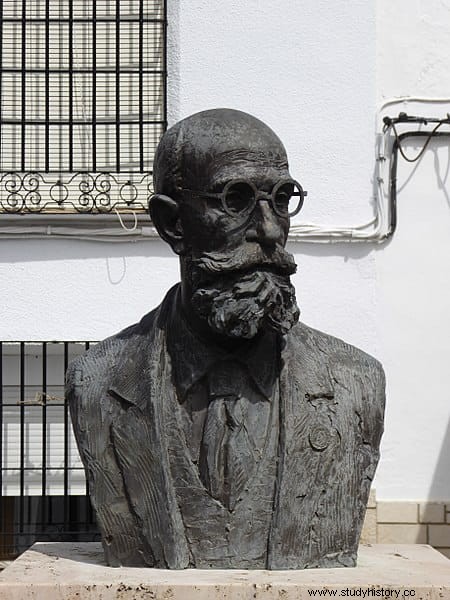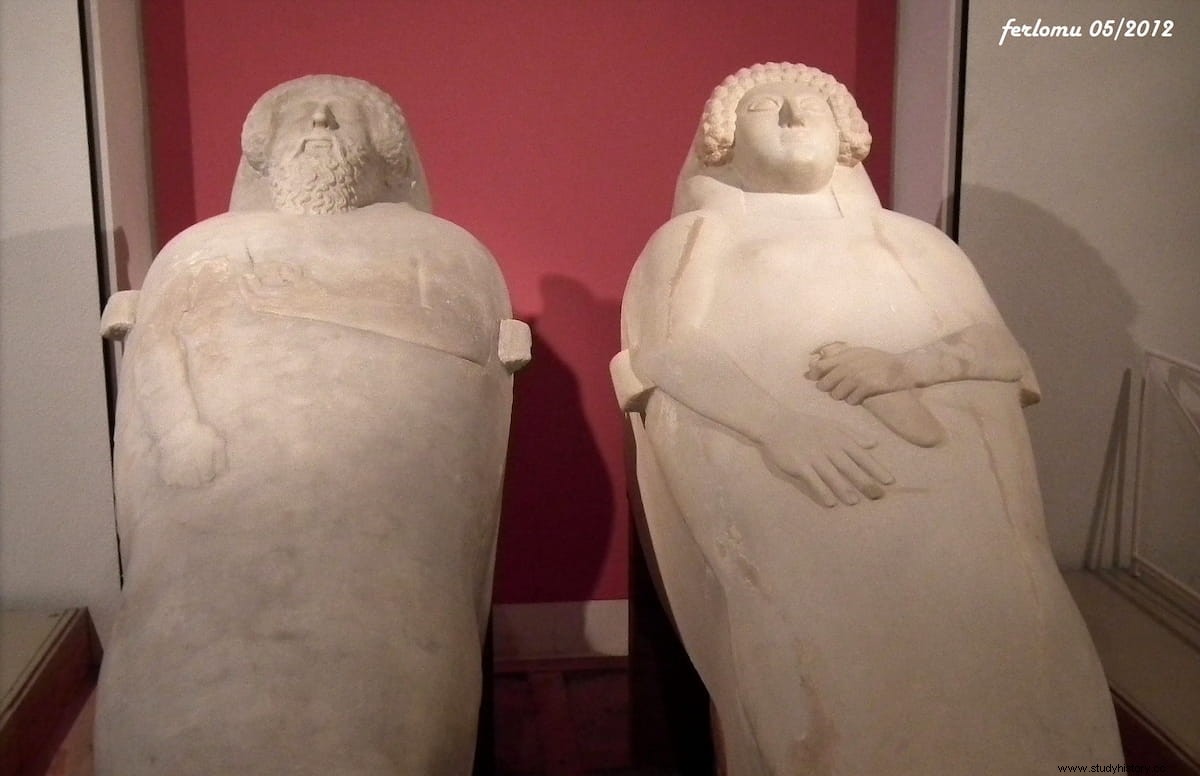In 1887, on the occasion of the celebration of the International Maritime Exhibition in Cádiz, the land where it would be located was cleared, in the so-called Punta de la Vaca of the Cadiz capital. The excavations revealed a necropolis with several Phoenician-Punic burials, about five meters deep, whose grave goods disappeared at the hands of the workers, who sold them to private individuals.
But a male anthropoid marble sarcophagus also appeared, buried in the rock and the hole covered with carved ashlars, all filled with clay. It is made up of two pieces of white marble, the box and the lid, on which is carved the figure of a recumbent man with an Egyptian headdress, a curly and symmetrical beard, his left arm folded across his chest and something that looks like a heart on the back. hand.
The right arm may have held a painted laurel wreath that has completely disappeared. His feet are bare and rest on a pedestal, with the big toe very far apart from the others, indicating the use of sandals. He has his eyes open and is dressed in a tight, sleeveless robe. It was most likely created in the city of Sidon or in southern Italy, hundreds of kilometers from the place where it was found, by highly Hellenized artists of Greek or Phoenician origin, around 450-401 BC.

The entire necropolis was destroyed on August 18, 1947 in the explosion of the Army magazine that devastated several neighborhoods of the city. The sarcophagus, together with other objects found in the necropolis, gave rise to the creation of the Archaeological Museum of Cádiz.
But before that, around 1904, the archaeologist Pelayo Quintero Atauri arrived in Cádiz, born in Uclés (Cuenca) in 1867, and who had been director of the excavations of the Celtic and Roman site of Segóbriga. In the capital of Cadiz, he worked as a drawing teacher at the School of Arts and Crafts, director of excavations for the province, director of the Provincial Museum of Fine Arts, member of the monuments commission, and other prominent positions.

At the same time he dedicated his archaeological efforts to the excavation of the Punic and Roman necropolises, recovering a large number of objects from both, such as jewels, urns, amphorae, ointment bowls and lanterns that are now kept in the city's archaeological museum. But Quintero was especially interested in the Phoenician sarcophagi. Since a male one had been found in 1887, he thought a female one would soon turn up as well.
He searched for it tirelessly until he left the city in 1939, of which there are numerous reports in the press of the time, and it is said that it even became so obsessive that he dreamed at night of his desired Lady of Cádiz . Unfortunately he never found her. Pelayo Quintero died in Tetuán on October 27, 1946.
Curiously, and in a twist of fate worthy of a Frank Capra film, on September 26, 1980, while excavating to lay the foundations of a new building on Ruiz de Alda street in Cádiz, a Phoenician female sarcophagus dating to c. the year 470 BC Not only that, but the building that previously occupied the site had been the chalet of the archaeologist Pelayo Quintero himself.

The Cadiz writer Felipe Benitez Reyes echoed this amazing coincidence in his novel Market of mirages published in 2007:
Of course, like any good story, the discovery of the Lady of Cadiz It has its share of conspiracies and theories. There is no shortage, and a simple search on the net proves it, who see too many coincidences in the matter:from those who think that Quintero himself hid the sarcophagus in his garden (it is not known for what purpose) to those who claim to have seen documents of the archaeologist where already before 1939 he mentioned its contents and trousseau. As is also often the case, no evidence of this exists, beyond words.

The Lady of Cadiz It is, like its male equivalent, a marble sarcophagus made up of a lid and a box, this time representing a female figure. At the time of its discovery, it still had traces of color pigments. His right hand is outstretched and his left hand holds an alabastron with a lid.
Inside, a funerary trousseau appeared consisting of two pairs of bronze eyelashes, five pendant amulets in the form of ureos (representation of the goddess Wadjet in the form of an upright cobra), a scarab (amulet in the form of a scarab) and four bronze nails. .
Both sarcophagi, which can be seen together today in the Museum of Cádiz, constitute the best representation of the Phoenician presence in Spain. As for Pelayo Quintero, since 2011 he has had a bust in the square that bears his name in Uclés, his hometown, while the Cadiz press remembers him as the man they never thanked .
